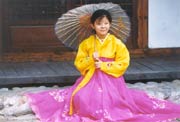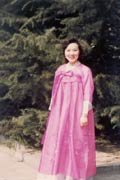|
"Compatriots in White Clothes"
The Korean nationality has always liked dressing in white plain clothes, and has been named "Compatriots in White Clothes". In the early days of settlement, most Koreans inhabited in mountain villages, so the raw materials of dresses were mainly flax and hand-loomed cloth grown and woven by them. At the beginning of the twentieth century, with the infiltration of capitalist economy and the introduction of modern culture, outside materials such as machine-loomed cloth, silks and satins began to be introduced in, and the colors of dresses and personal adornments became diversified since then.
The traditional Korean clothes include upper outer garments for males and females, trousers, skirts, coats, robes, waistcoats, large bamboo hats and shoes resembling boats. In addition to everyday clothes, there are clothes for etiquettes, such as dresses for one full year of life, wedding dresses, and sables.
 The men's upper outer garment is with slanting front, bag-sleeve, left sleeve, and without any fastener. At each side of the front of the garment, there is a ribbon, which is twined in the upper middle place of the right front of the garment. The Korean men also like wearing coats, say "waistcoats" (weskits) in black or some other colors with fasteners. In winter, they often wear short overcoats or overcoats made of cotton or fur, as well as pantalets with wide waists and loose crotches of trousers and trouser legs, which are convenient for crossing their legs while sitting on kangs (heated brick beds). This kind of trousers is worn by tucking up the front of the waist of trousers before sashing the waistband, and then binding the lower part of trouser legs with cloth. The men's upper outer garment is with slanting front, bag-sleeve, left sleeve, and without any fastener. At each side of the front of the garment, there is a ribbon, which is twined in the upper middle place of the right front of the garment. The Korean men also like wearing coats, say "waistcoats" (weskits) in black or some other colors with fasteners. In winter, they often wear short overcoats or overcoats made of cotton or fur, as well as pantalets with wide waists and loose crotches of trousers and trouser legs, which are convenient for crossing their legs while sitting on kangs (heated brick beds). This kind of trousers is worn by tucking up the front of the waist of trousers before sashing the waistband, and then binding the lower part of trouser legs with cloth.
 Women often wear short coats and long skirts. Their upper outer garment resembles that of men's, but is shorter and smaller. The sleeves are long and narrow with long ribbons that are made from silks and satins in red, purple or other colors. The cuffs and front of young women's garment are often beset with colored silk and satin edge. In winter, young women wear overcoats, and older women add waistcoats with fur inside and silks and satins outside. Long skirts are classified into two types: twined skirts and pailform skirts. People of middle age and advanced age usually wear the former. The twined skirt is an un-sewed skirting that is constituted by the waist, the wrinkle and the band of a skirt. It is narrow above and wide below, and reaches the feet. The wrinkle of the skirt is fairly wide with many a minute pleat. The band of the skirt is sewed at the two sides of the waist of the skirt, and is twined around the waist before being tied at the right side of the waist. The skirt of this sort should be worn with plain and white underskirt inside. Middle-aged and young women and maidens usually wear vest-like pailform skirt with pleats. The length of the skirt surpasses the knees and is convenient for laboring. The colors of their garments and skirts are multifarious. Maidens, frails and women of middle age and advanced age prefer various colors. In the past, women of middle age and advanced age favor plain and white garments and skirts, while rosebuds and young ladies prefer yellow garment and pink skirt. With the development of the textile industry, the costuming colors used by women nowadays are brighter and more colorful with varied patterns. But the traditional ethnic style of short garment and long skirt remains unchanged for a long time, because it accords with the aesthetic judgment of the Korean women, and fully reflects their virtues of being tender, kind, diligent as well as honest and simple. Women often wear short coats and long skirts. Their upper outer garment resembles that of men's, but is shorter and smaller. The sleeves are long and narrow with long ribbons that are made from silks and satins in red, purple or other colors. The cuffs and front of young women's garment are often beset with colored silk and satin edge. In winter, young women wear overcoats, and older women add waistcoats with fur inside and silks and satins outside. Long skirts are classified into two types: twined skirts and pailform skirts. People of middle age and advanced age usually wear the former. The twined skirt is an un-sewed skirting that is constituted by the waist, the wrinkle and the band of a skirt. It is narrow above and wide below, and reaches the feet. The wrinkle of the skirt is fairly wide with many a minute pleat. The band of the skirt is sewed at the two sides of the waist of the skirt, and is twined around the waist before being tied at the right side of the waist. The skirt of this sort should be worn with plain and white underskirt inside. Middle-aged and young women and maidens usually wear vest-like pailform skirt with pleats. The length of the skirt surpasses the knees and is convenient for laboring. The colors of their garments and skirts are multifarious. Maidens, frails and women of middle age and advanced age prefer various colors. In the past, women of middle age and advanced age favor plain and white garments and skirts, while rosebuds and young ladies prefer yellow garment and pink skirt. With the development of the textile industry, the costuming colors used by women nowadays are brighter and more colorful with varied patterns. But the traditional ethnic style of short garment and long skirt remains unchanged for a long time, because it accords with the aesthetic judgment of the Korean women, and fully reflects their virtues of being tender, kind, diligent as well as honest and simple.
A Nationality that Honors the Teacher and Reveres His Teachings
<<
Rice, Hammered Cake & Cold Noodle
>>
|

